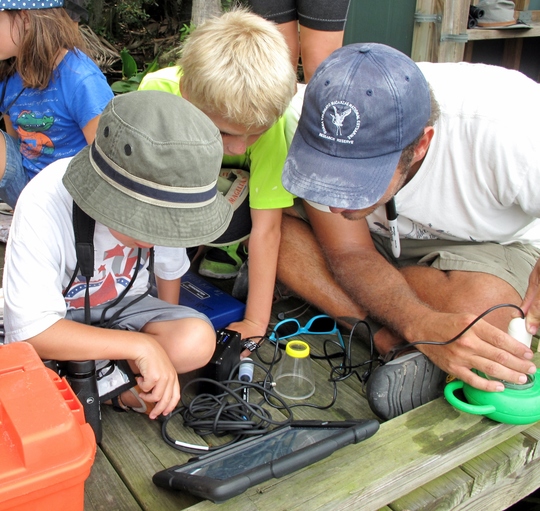FOR IMMEDIATE RELEASE: Nov. 25, 2014
GTM RESEARCH RESERVE HELPING CREATE ESTUARINE-SMART KIDS WITH ELECTRONIC DEVICES
~The education program numbers have increased with the use of smart devices~
 Education coordinator Kenneth Rainer shows students how to use a smart device for a project.
PONTE VEDRA BEACH – The GTM Research Reserve's environmental education department is helping create estuarine-smart kids with handheld electronic devices as a key component of the K-12 Estuarine Education Program (KEEP).
"Students already know how to use this technology and we're demonstrating its relevance to science," said Kenneth Rainer, education coordinator at the GTM Research Reserve. "The reserve's goal is to keep students engaged and stimulate their interests in field research and the estuary, and in so doing create estuarine-literate students, which will ultimately result in resilient communities."
Combining digital literacy with a field experience is a significant part of the GTM Research Reserve's KEEP programs. The programs pair iPads with the same high-tech environmental sampling equipment used by the reserve researchers. Programs that incorporate the smart devices have been developed for second, fourth and seventh graders, along with high school students.
"Normally, teachers tell students to put their cellphones and tablets away before starting a lesson," said Michael Shirley, director of the GTM Research Reserve. "Here at the reserve, these kinds of electronic devices are a critical part of the environmental education program."
Middle and high school students go to the beach and collect marine debris, then use a tablet to document their find. The gathered information is uploaded to a web-based database that the teacher accesses back in the classroom.
In another program, students create short video journals on their smart devices. Each participant has a goal to create a 30-second video describing what they are doing in the field, defining the problem, stating observations, forming hypotheses, describing methods used and recording conclusions.
"The devices get used over and over again, so the initial investment is well worth it," Rainer said. "One of the lessons we learned is that you can't have 45 students around one smart device. My ultimate goal is to have one device for every five students."
After two years, there is enough student-collected data to create graphs and see data changes. Some of the data collected has included recording air temperature, wind speed, water temperature, salinity, pH factor, dissolved oxygen and turbidity. This technology allows students to get their hands on real and relevant research equipment, which enables them to understand the process and importance of water quality and weather studies. The data collected by the students operates well with the data collected by reserve researchers.
Rainer obtained three grants to purchase iPads for student use and is seeking funding to purchase more. He pointed out that the education program numbers have increased dramatically with the integration of these devices.
For more information on the Guana Tolomato Matanzas NERR education programs, click here or contact Kenneth Rainer at 904-823-4500 or Kenneth.Rainer@dep.state.fl.us.
|